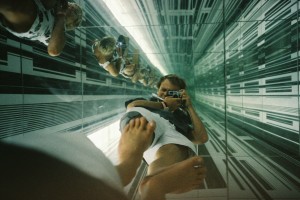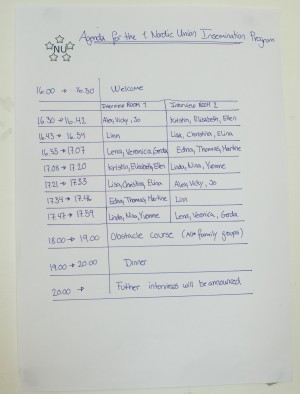I would like to address the ways in which larp can be used as Performance-as-Research (PaR), and the ways in which documentation practices can serve that purpose. It is my intention to bring larp into the conversations predominant in performance studies about the ethics and efficacy of documenting ephemeral events, encourage critical approaches towards documentation practices, and to open up further discussion around documentation practices of larps and other analog games in various communities around the world. In short, we must question why we document larps. If we document our larps out of the desire to preserve the unique, ephemeral event that can never be recreated (that resists scientific reproducibility), then we must not forget that the very thing that gives larp such power is that it remains not in written documents, but in the imaginations of its players, the very place from whence the larp itself was created.
Larp has enormous revolutionary potential to unsettle the textocentrism of the academy.
Other larp scholars, such as Marjukka Lampo, have also found Performance Studies a useful lens through which to understand larp, particularly as it relates to ephemerality. However, I am interested in an approach to larp that challenges this traditional understanding of performance. In her seminal text on archiving live performance, Rebecca Schneider offers a counter-suggestion to the taken-for-granted definition of performance in the field of performance studies as that which is ephemeral, or that which cannot remain. She posits that this is not the only way to understand performance, and that it is, in fact a perspective that is necessarily established and informed by oppressive patriarchal and capitalistic traditions. In Schneider’s utopic perspective on performance as something that certainly does remain but just “remains differently,” performance becomes, therefore, a powerfully subversive force that resists the “patrilineal, West-identified (arguably white-cultural) logic of the Archive.” The “body-to-body transmissions” of performance are simply a different way of learning, teaching, and knowing. These lessons and discoveries are written in our bodies and documented in our memories. And if the academy is an institution established by, primarily controlled by, and still operating within the rules of this Archive, then Schneider’s notion of performance further challenges the traditional academic view of knowledge itself, as noted by Simon Jones, transforming it from a static noun into an active verb (and therefore ephemeral and unstable): knowing. To approach knowing from this perspective is to unsettle the authoritarian concepts of authenticity as well as objective truth, and to acknowledge that performance/practice itself can be a form of research (PaR).

Jones describes one of the ways in which PaR diverges from our traditional understandings of valid knowledge by analyzing the ways in which this type of research is distinct from scientific traditions. Whereas scientific practices aim to reduce knowledge to finite, quantifiable facts and controllable events that can be replicated in identical conditions by anyone who has access to the blueprint, performance acknowledges the mutable, personal, chaotic, infinite, and “uncanny” ways of knowing in which we all are immersed in our day-to-day lives. Jones, therefore, draws a distinction between the scientific write-up, and the writing alongside which must occur when documenting performance. This writing alongside acknowledges the fact that document does not equal the documented. Writing alongside is a practice in awareness and acknowledgement of the limits of documentation. Whereas scientific writing-up in is a “blueprint” for reproducibility, writing alongside can only point to the thing that is necessarily irreproducible. As noted by Evan Torner, it is a frustration that can plague the larp documenter, therefore, that no matter how exhaustive or detailed the larp archive may be, the diaries and photos and props and films are only ever empty indices of that which no longer remains in the scientific world, but a performance which has left its mark, often in ways in no way insignificant, on the bodies and in the psyches of the players themselves.
All is not lost, however. Film studies scholars such as Bill Nichols and Stella Bruzzi have identified a genre of documentary film that challenges traditional notions of authoritative knowledge and which offers instead “an expressive quality that affirms the highly situated, embodied, and vividly personal perspective of specific subjects” . Although Nichols’ influential taxonomy of documentary subgenres was developed specifically for documentary film, these modes can be useful in analyzing any kind of documentation practice, particularly larp documentation. Nichols’ taxonomy provides a spectrum that starts at one end with a “what-you-see-is-what-you-get” model, and reaches on the other to what he terms the Reflexive and the Performative modes of documentary. In the Reflexive mode, documentary filmmakers showcase their awareness of their medium by inserting themselves into the final product. In the Reflexive mode, the documenter does not try to erase her intrinsic influence over the shaping of the narrative. The Performative mode takes this one step further and acknowledges the inauthenticity of everything, often by incorporating elements which are not easily distinguishable as either fact or fiction. Performative documentary, therefore, subverts the false binary between authenticity (revered by science) and inauthenticity (exemplified by performance, practice, and larp).
[youtube=http://www.youtube.com/watch?v=4BP7_6XXNq8]
Performative documentary footage from one of the first runs of Mad About the Boy, Norway, 2010.
Performative documentation for larp does exist, but it is not currently the predominant style. For an example of a typical contemporary larp archive, we may look at one larp in particular: Mad About the Boy, designed by Tor Kjetil Edland, Margrete Raaum and Trine Lise Lindahl. It is a larp which tells the story of a world of women who face the task of rebuilding society after a mysterious virus violently and suddenly kills every human on the planet with a Y chromosome. The game has thus far been run four distinct times in three different countries, and has therefore amassed a diverse, robust collection of documentation from its various iterations. From this collection we may begin to be able to identify familiar modes of documentation, as well as new ones unique to larp alone. Perhaps one day we will see the development of larp’s own taxonomy of documentation practices.
To begin with, most larp archives have at their core the incidental materials which make up the scripts, rules, instructions, or other kinds of blueprints for the game. The full set of such materials for MAtB are available online for those who will be running or playing the game. They may also be accessed by those who have never and will never participate in the game, but these kinds of blueprints are arguably empty of the “true” experience gleaned from the body-to-body transmissions experienced in live role-play.
That is why the next step, typically, is to produce a “write-up” of sorts, explaining what happened in one particular run of the game. These write-ups may come from the designers, organizers, or players themselves, and may occur in more formal circumstances (such as at conferences or in edited books), or in more informal ways, such as on personal blogs.
[youtube=http://www.youtube.com/watch?v=UG8spVaD2Tg]
MAtB designer and organizer, Tor Kjetl Edland, presents on the game at the 2011 Nordic Larp Talks.
There are also communal documentation efforts such as the Nordic Larp Wiki, as well as more private, semi-inaccessible ones such as in password-protected photo albums and forums (some public if you know where to look), as well as the overwhelming, untrackable mass of email threads, and comments on Facebook, G+, and personal blogs which are accessible only to those who are in-the-know.
Finally, there are the traces of performances as captured in photographs and film, as well as objects and artifacts from the live game-play itself, such as costumes, props, or even character diaries. These kinds of documentation, which point to the simultaneous existence of players and characters and confuse the distinctions between them, are the ones which are most performative, which write alongside the larps, and which have the most potential, therefore, to emphasize the unique ways of knowing that occur only within the ephemeral game experience, and which remain in the bodies of the players.

Some of these types of documentation will be more suited to different purposes than others – and this is why it is important for us to think critically about why we choose to document our games. If larp indeed has revolutionary potential in its innate ability to resist the rigid standards of the Archive, and if we want to harness that revolutionary potential to provide a platform for honoring different ways of knowing – particularly ways of knowing that resist being put into words – then we must strive to engage in modes of documentation that tend more towards reflexivity and performativity. It is impossible to recreate the original larp, or to capture the knowing from the larp into knowledge fixed on paper, film, or in objects. To attempt to do so is futile. Instead, we must approach our documentation practices as writing alongside, as opposed to writing-up. Documentation can serve many purposes: the effort lends itself to growing the community (whether or not this is always seen as a good thing), provides a semblance of the ephemeral experience of the larp for those who could not participate, and also serves as justification for the hobby. The latter is the point that I would like to take up. Larp has enormous revolutionary potential to unsettle the textocentrism of the academy. That being the case, to what end are documentation efforts in place to try to fit larp into a textocentric mold, and in what ways can our future documentation efforts more deliberately challenge that mold in order to better harness the unique qualities of larp?
In closing, as we move forward in thinking critically about the ethics and efficacy of larp documentation practices, we have many questions left to consider: For example, what does it mean to impose the non-fictional genre of documentary onto inherently fictional stories in larps? Or, to what extent are larps fictional – where do the boundaries of performance and reality begin to dissolve? What does it mean to impose the strictures and structures of the academy on a medium whose very strength is in its ability to resist and transcend those structures? Are we perhaps doing a disservice to larp by trying to fit it into certain (textocentric) standards through documentation practices? More importantly, when looking at the ways in which documentation is approached in different play cultures, what does it mean to utilize a discourse that is laden with socio-economic stratification in some environments, but not in others? Why has documentation evolved as an indispensable practice in some play cultures and design traditions more than in others? What different forms of documentation currently exist? What do they seek to do and what do they achieve? What forms of documentation might evolve in the future? On whose authority are these stories told? Whose voices are included in different documentary practices and whose are left out?
–
Featured image by Jo Guldi @Flickr
–
Documentation editor, Emma Leigh Waldron, is a Doctoral Student at UC Davis in the department of Performance Studies and a graduate of the MA Performance Research program at the University of Bristol, where her thesis was entitled: “Beyond Binaries: Questioning Authentic Identity in Hedwig and the Angry Inch“. Previously, Emma studied Performance Studies at New York University, and earned her BA at Rutgers University where she studied English, Art History, and Theater Arts.
Emma is a theater artist, larp organizer, and researcher who is interested in exploring performances of intimacy and the intimacy of performance. Emma’s research focuses on the affective power of performance, the intersection of sex/gender and performance/play, and in exploring where the boundaries of performance (and the perceived “inauthentic”) begin to dissolve. Through her work about what it means for the body to perform and be performed upon, she attempts to explore the reciprocal relationship between performance and affect and how, why, and if we can perform intimacy. Emma sees performance as a particularly powerful tool for feminist and queer activism. Her research interests revolve around the exploration of identity, sexuality, immersivity, and embodied knowledge, and she is particularly interested in the ways in which these issues are challenged and played with through the practices of larp, porn, and drag.

